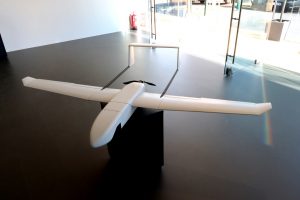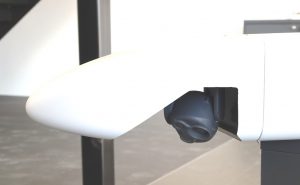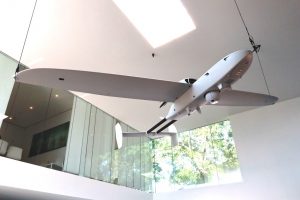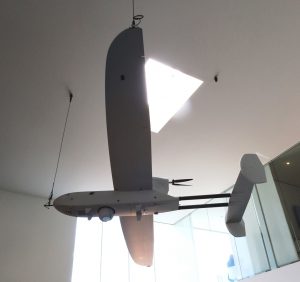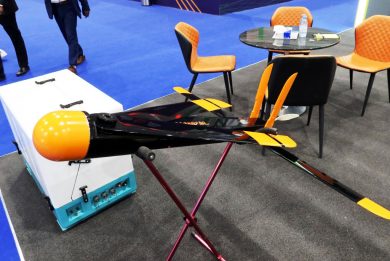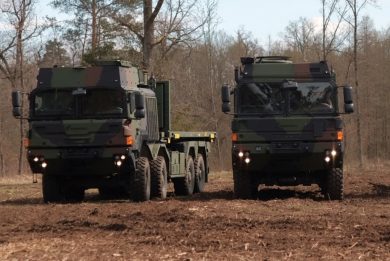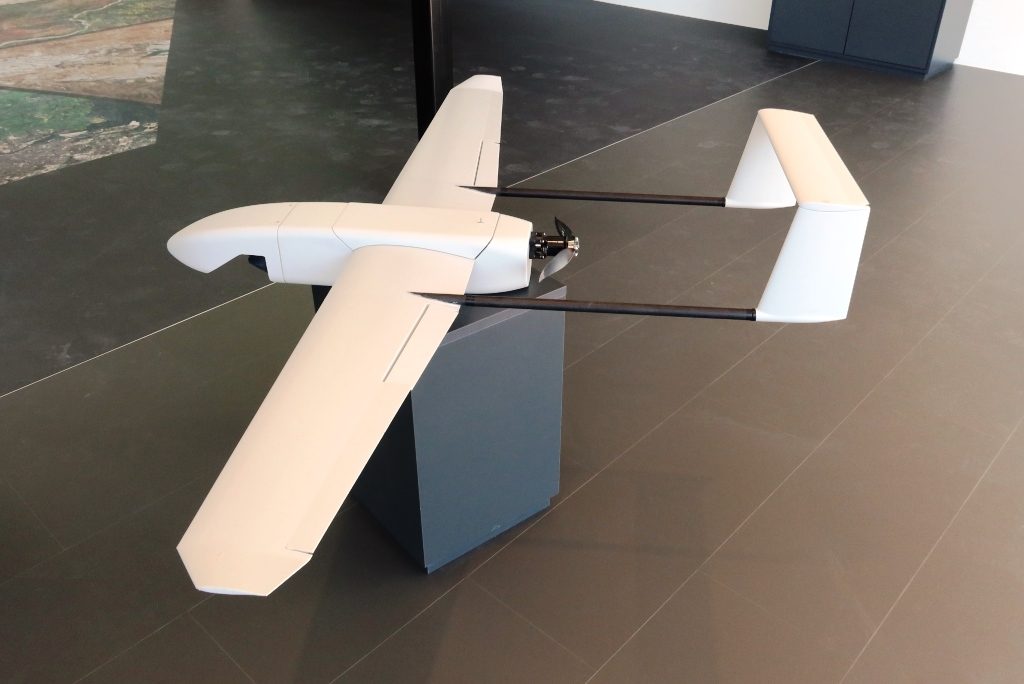
Rheinmetall: back into the UAS business
Within the Rheinmetall Group there is a subsidiary, fully owned by Rheinmetall, which is the only branch of the overall group to be an approved Aeronautical company by German regulating authorities for development, production and maintenance (MRO). Its name, Rheinmetall Technical Publications GmbH (RTP), indicates its former main business area, which is the production of technical documentation for major companies in the land, naval and air domain. Due to customer needs the company was formed as an integrated logistics service provider and finally got approved as an aeronautical company in 2016.
RTP is part of of the division Electronic Solutions and has today a manpower of around 520 people, split between 11 locations in Germany, the three subsidiaries in Bristol, United Kingdom, Zurich, Switzerland and Canberra, Australia, and in the delivery centres in Bosnia, India and Poland,
Things have changed in late 2021 for RTP. EMT Ingenieurgesellschaft Dipl.-Ing. Hartmut Euer mbH, a Bavarian company located in Penzberg, around 50 km south of Munich, The company was the manufacturer of two UAS in service with the German Army, the A and the Luna, German Luna NG (Next Generation) was in use in Pakistan Army and Navy. In January 2022 RTP took over EMT activities as part of the digitisation strategy of Electronic Solutions.
With the cash injection of a major group, some of the projects that risked to be shelved are now once again progressing, bringing Rheinmetall back into the aviation business. However the Düsseldorf group looks beyond the mere UAS aspect. The new assets support the aim of Electronic Solutions to carry out the digitisation of the battlefield; the drone in the air provides additional information to the ground into the IdZ Soldier System and fighting vehicles networks. Six months into the new business, the company first objective is transferring existing contracts from EMT to RTP both for the national and the export customers, then exploiting opportunities around the world based on current portfolio, while in parallel developing systems in service, solving obsolescence issued and integrating new payloads, and finally developing new systems, autonomously or in partnership with other German companies. The current RTP portfolio in the UAS field includes three systems, the Aladin, the Luna and the Luna NG.
Starting from the smaller one, the original Aladin has a 1.46 meters wingspan and is a 1.57 meters long airframe with a less than 4 kg Maximum Take-Off Weight (MTOW): it is powered by an electric motor with Lithium-Polymer batteries that activate a two-blade pulling propeller, and is in service with the German Army that uses it mostly when operating downrange.
At Eurosatory Rheinmetall exhibited the Aladin 2.0, which is a wholly new product although it remains in the same category. The new UAV, which is of course proposed to the Bundeswehr for the replacement of the previous generation mini-UAV, has a MTOW lower than 5 kg and carries a 750 grams payload. It has a wholly new configuration, with a mid-wing, a pushing propeller, a twin boom tail with vertical rudders and high stabilizer. As the is now free from the propeller, the Aladin 2.0 is fitted with a front modular cone that integrates the payload and is easily interchangeable on the field thanks to a quick connection system both mechanical and electrical.
It is activated by a brushless electric motor powered by an 8,000 mAh/14.7 V battery ensuring 45 minutes endurance. Maximum operational range is 15 km, ceiling being 3,000 meters while operational flight level is around 300 meters above surface. Maximum speed is 130 km/h while operational speed is 60 km/h. According to information gathered at Eurosatory, the Aladin 2.0 is not audible when flying higher than 120 meters over the ground, and cannot be seen when flying at 250 meters. The ground segment is made of two laptops and the data link, one computer being used to fly the air vehicle while the second is used by the payload manager.
The Luna is a much bigger system, with a 4.17 meters wingspan, a length of 2.38 meters and a MTOW of 40 kg, with a 2-cylinder 2-stroke fuel injection engine mounted in a pod over the fuselage and fitted with a pushing propeller. Take-off takes place by catapult, while landing can be done using a net or a parachute, system endurance being over 6 hours. It is in service in Pakistan and in Germany and has already over 13.000 flights for the Bundeswehr. A series of upgrades are being considered to keep the system viable well into the next years. Optronic advances should allow installing a much more effective sensor head for the same weight, or even less, while the link with the Ground Control Sttaion, which will also be renewed, will become digital, an option for a SATCOM data-link being also planned, as well as the link into forces’ control and information systems. RTP is looking at many other potential payloads, starting from electronic warfare, a first integration has been that of a scanner capable to intercept SATCOM, moving to payloads capable to support soldiers in the field, such as the Rheinmetall Rosy screening system, as well as signal relay solutions making it multipurpose. The engine might also be considered for replacement; the original engine was developed within EMT, and Rheinmetall is considering if developing a solution in house, exploiting the knowledge within the company automotive sector, improving the current solution, or looking at the market.
Besides developing an upgrade package to keep the Luna operational, RTP has obviously also picked up the Luna NG programme, the acronym standing for New Generation, the air vehicle being on show at Eurosatory. Of a different class compared to the original Luna, it has an over 100 kg MTOW, a 5.34 meters wingspan, architecture similar to that of the original Luna and aims at 12 hours endurance. The Luna NG-A, for “Ausland” which indicates it is meant for the export market, has already found a launch customer, and since January 2020 it is in service with the Pakistan Navy; the air vehicle delivered to that service has a 10 hours endurance and is launched and recovered the same way of the Luna. RTP is currently working on the Luna NG-B, the last letter standing for “Bundeswehr”, which is being designed according to German requirements, the system being known as Husar in the Bundeswehr. EDR On-Line understood that the launch of the development should get the green light very soon, Rheinmetall counting on its great growth potential to generate a smart multipurpose platform for the integration of newest payloads according to customers’ needs. Having been delayed due to the EMT critical financial situation in the past years, the next challenge will be certification, for which the company is working closely with the customer and with the Luftfahrtamt der Bundeswehr, the Federal Armed Forces Aviation Office.
Weaponisation is an issue that came up often during the first talks with customers and potential customers, therefore RTP is already considering how to install weapons under the wings of its UAVs. Due to its higher MTWO and the consequently higher payload, the Luna NG is definitely the platform of choice for installing a number of different payloads making it a multirole drone.
Another key feature of the Luna NG-B will be the optional Vertical Take-Off and Landing (VTOL) capability, which is part of German requirements that include a plug and play solution allowing for a quick transformation of an ordinary Luna NG into a VTOL model. RTP has already tested a solution which sees the addition of one boom under each wing, carrying two rotors, one ahead and one behind the wing, which provide sufficient lift for VTOL manoeuvres, the airframe then shifting into aerodynamic lift when the main engine activating the pushing propeller enters into play. For the time being only take-off and landing procedures were tested, EDR On-Line understanding that the booms also contain the batteries activating the electric motors that move the rotors. The company is trying to keep the VTOL kit as simple as possible also for certification purposes, which might prove not as easy as it is something quite new. Adding the VTOL kit means increasing weight by 25-30 kg as well as worsening aerodynamics, which in the end would reduce horizontal flight performances at speed. To maintain current performances in the VTOL configuration the base performances of the Luna NG will need to be improved. Some weight saving can be made on the airframe, however this should remain capable of withstanding the 15 g acceleration during the catapult launch, while some more mass can be spared working on the propulsion system, Germany requiring the full 12 hours endurance according to a demanding mission profile; EDR On-Line understanding that with a more easy mission profile the airframe might fly longer.
RTP was recently asked by a potential customer to develop a new UAS in the same category of the Aladin, with a wingspan of 1.8 meters, and work has started immediately exploiting existing building blocks and rapid prototyping techniques in order to answer that need.
However beside the purely aeronautic work, RTP is looking at integrating its UAVs into the networked environment making them force multipliers, “Our aim is to become the system house for tactical UAS, and we have our own drones, we have C4I integration capabilities within Electronic Solutions, we can do payload integration and data analysis of what we get from the air, and we also want to integrate drones provided by other OEMs in our system of systems, and this is the strategic idea being the integration of the Bavarian company assets into RTP,” the company CEO said adding that RTP is focusing on Artificial Intelligence (AI), aiming at automating intelligence assessment, i.e. on the number of enemy assets visible on the ground, to help the decision making process. AI is also being also used to steer the right information, at the right moment to the right person, generating layers of intelligence, but this is happening at the higher echelon. For the time being, with the integration of the EMT business into its aviation company Rheinmetall is back into the UAV world, and according to what EDR On-Line could pick-up during the meeting, Rheinmetall Technical Publications might soon change its name to better represent the new reality.
Photos by P. Valpolini

